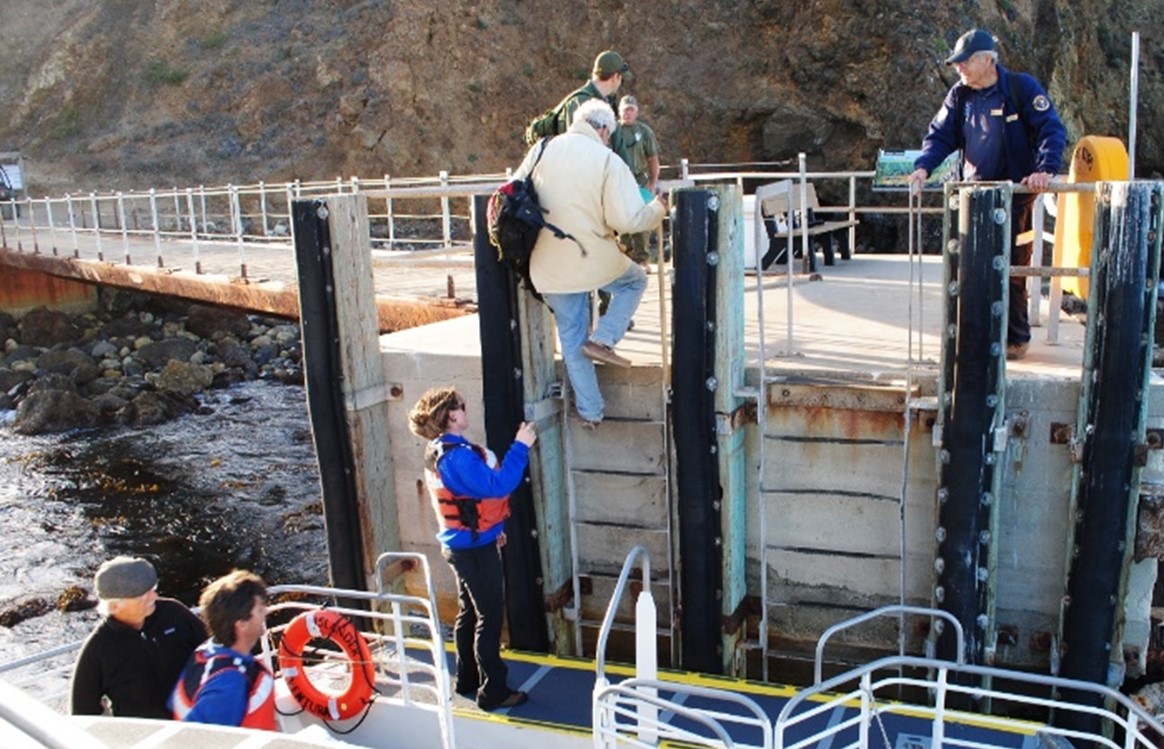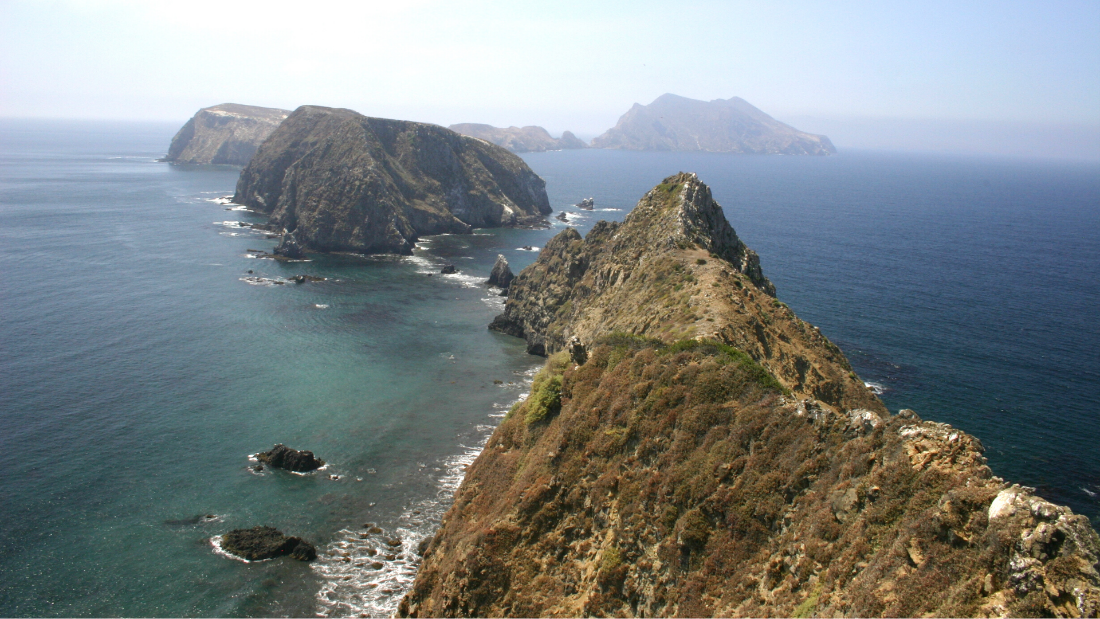The Reconstruction of Scorpion Pier: Building for Resiliency
March 11, 2021 – Josh Burnam
Scorpion Pier provides visitors from around the world access to Santa Cruz Island—the most visited island in Channel Islands National Park, California. The pier is located at Scorpion Anchorage, a semi-protected ocean environment that poses both opportunities and challenges to the Park and visitors.
The former pier was a repurposed flatbed railcar installed in 2000, and was only intended to be a temporary, low-cost solution for providing urgent access to the Santa Cruz Island and the historic ranch district. This pier was rapidly deteriorating due to wave action and corrosion. Disembarkation required the use of ladders in pitching and shifting waters and docking boats was unsafe in heavy seas. Additionally, boats could not be moored to the dock in even modest (1- to 2-foot) waves; instead, boat operators either hovered or thrust their boats into the dock fenders during loading and unloading.
The challenges didn’t end at the water’s edge. After disembarking, visitors were required to traverse an uneven, unpaved access road that was difficult to negotiate, especially for older individuals or visitors with mobility challenges, or for anyone carrying gear. In addition, the road required repair several times a year due to storms, wave erosion, and flooding of nearby Scorpion Creek.

The prior embarkation process required passengers to climb—one person at a time, often while carrying heavy gear—and sometimes during moving seas. The former pier and access road were deteriorating and did not meet National Park Service requirements for administrative use or safe visitor access.
Replacing Scorpion Pier to Improve Park Operations and Enhance the Environment
The National Park Service (NPS) recognized that a permanent solution was needed for the Scorpion Pier, in order to support the approximately 1,000 boat landings a year with safe, efficient and environmentally responsible access to the Island. As part of the planning for the new pier, there was another element to consider: predicted sea level rise and its future impacts at the site. To address these challenges, NPS hired Anchor QEA to design a replacement for the old pier with a new, modern pier, and reconstruct the road in a better location. The project needed to be both designed and constructed in a challenging location, while addressing safety and environmental impacts, and anticipating predicted future sea level and future visitation levels, which are anticipated to remain at maximum capacity.
Our team managed the decade-long program of site investigations, design, permitting and compliance. When we began leading the design and construction for this project, it quickly became clear that constructing the pier and road would require adapting to several key variables: equipment access and availability at a remote island, volcanic bedrock beneath the seafloor at the pier site, the major implications of rising sea levels and storm impacts on the pier design, and expensive road repairs adjacent to sensitive cultural areas.
The natural and physical complexities were overlain by an extensive environmental compliance and permitting process since the project construction occurred within the overlapping boundaries of a National Park, a National Marine Sanctuary, a State Marine Reserve, and Chumash tribal lands. Approvals we managed on behalf of NPS included obtaining Coastal Zone Management Act consistency; completion of an Environmental Impact Statement (EIS); assisting with a significant National Historic Preservation Act Section 106 process, owing to the presence of cultural artifacts on site; and providing support for detailed Endangered Species Act and Essential Fish Habitat consultations; and many more.
Constructing on a Remote Island with Limited Equipment Access
Building a new pier and road on a remote island 20 miles from the mainland posed the challenge of having a very limited access to construction equipment. All heavy equipment and supplies were therefore brought to the site via barge.

Visits to Channel Islands National Park’s Santa Cruz Island have risen steadily in the past, and are anticipated to remain at maximum capacity in the future, as determined by concessioner contract, weather, park rules, and regulations.
Addressing Frequent Road Repairs
The best way to end expensive and frequent repairs of the access road, and to increase accessibility for visitors, was to rebuild the road in a better location. Anchor QEA designed a replacement that was elevated above predicted storm impacts, away from the water sources that damaged the old one. The road is supported by a rock dike, fill, and a revetment, in addition to a pre-cast concrete wall at the entrance of the pier which prevents roadway backfill from escaping, reducing the need to continually repair and regrade the road, and ending repairs adjacent to extremely sensitive cultural areas. Moving the road also eliminated potential impacts to these areas due to periodic road grading. Finally, to improve the road surface for walking and accessibility, finely graded crushed rock was placed.
Building a Pier with Volcanic Rock
The seafloor at Scorpion Anchorage comprises beach deposits consisting of sand, gravel, cobble, and boulder, underlain by hard volcanic rock. To construct the replacement pier, holes in the bedrock, called sockets, for the piles were created with a down-the-hole rock hammer drill. Thus, the pier was constructed inside out—meaning within its own footprint. An air-driven rock hammer was used to create the borings in the volcanic rock. At each location, a temporary staging platform was placed to support the pile drilling equipment and a crane advanced along the length of the pier, constructing the pier progressively. Waste materials from the drilling process were extracted and contained. Wastewater was filtered, treated, and discharged back to the ocean. This innovative method eliminated the direct discharge of any drilling wastes to the ocean at this extremely sensitive site.
Anchor QEA’s innovative pile installation method both allowed for installation into volcanic rock, and eliminated the discharge of any drilling wastes to the ocean at this extremely sensitive site.
Accounting for Sea Level Rise and Storm Impacts, and Designing a Robust Pier
Anticipated sea level rise had implications for the new pier design, as well as for the dynamics of Scorpion Creek during large storm events. Current predictions range from as much as 1.1 feet by the year 2050, to as much as 3.2 feet by 2100. The new structure had to be designed to accommodate both flooding and future projected changes in sea level without the need for a full replacement. To address these needs, the new pier was designed to adapt to both current and future projected sea levels with a design structure that could be “raised” in place, through the use of steel piles and superstructure that can be modified and elevated in the future.
The design deliberately enabled the re-use of the existing 90-foot-long bridge/gangway that had been used temporarily after the previous railcar “bridge” deteriorated. This bridge was converted into an articulating gangway supported from a platform that could be raised and lowered to the desired height of an approaching vessel based on the appropriate tide. Additionally, to build the pier from the inside out required assembling a 110-ton crane upon it. The pier would never normally see this load, but to support the crane, the steel piles walls are approximately 50% thicker than is otherwise needed. This is turn also greatly enhanced the use of the pier for future cargo operations.
The use of a steel superstructure ensures the ability to structurally raise the pier in the future, allowing the new pier to be adaptable to increasing sea level rise, storms, and wind and wave conditions.
Built to Meet the Needs of Today and Tomorrow
The Scorpion Pier reconstruction ultimately improved overall park operations, created a safe and enjoyable experience for decades of future visitors, and made some notable enhancements to the environment. Designed and constructed to adapt to rising seas, the new pier can be raised in the future, maximizing both longevity and ease of maintenance. The new, relocated access road reduces the continual need for repairs and regrading, along with the associated harm to the surrounding environment.
The design and the construction methods eliminated discharge of any drilling wastes to the ocean and increased both the resilience and robustness of the new pier, greatly improving NPS cargo operations and substantially reducing the need to use a landing craft approach to deliver equipment to the park. The new pier enhances safety, operations, and visitor access, and addresses the potential impacts of rising seas through innovative design and construction—all while ensuring no disruption to the marine environment.
Related Insights
Chesapeake Bay Dead Zone Conditions Improved in 2020
December 3, 2020 – Anchor QEA and the Virginia Institute of Marine Science
Continue Reading »
